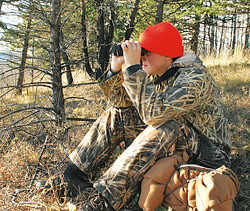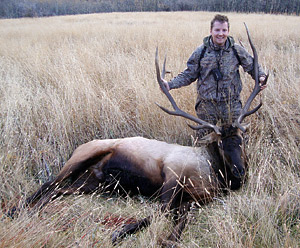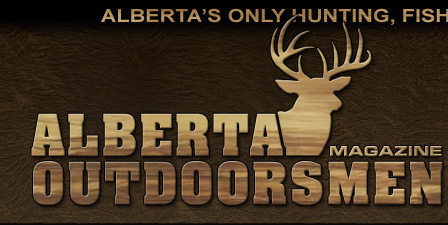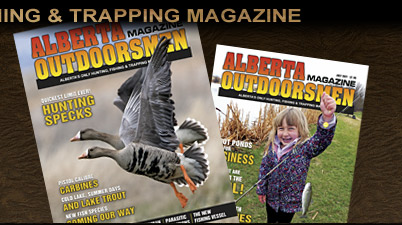Anyone who has spent time in the Alberta foothills during the fall understands the allure of rolling hills covered with aspen groves, pines and open meadows against the backdrop of the Rocky Mountains.
I live for fall days in this region of the world and to me it is my holy ground. I have been hunting here for a number of years and I consider myself lucky to have married into a family with a zeal for the outdoors. My brother-in-law and hunting partner, Luke, is the youngest of three generations of hunters that share the same passion for this special part of Canada. The stories and traditions go back four decades and this year I have been blessed to be part of another chapter in that rich history.
Luke and I have been scouting a valley in one of our favourite spots for close to a year. Situated in the forestry reserve, we noticed that it was not getting as much attention from other hunters that frequent the area.
Luke and I decided to take the day off to hunt the rifle season opener, which fell on a Monday. Our schedules meant we had to settle on a day hunt rather than camp out.
 |
| Luke Makowski glassing the area. |
As we drove along the bumpy trail into the spot, we passed many hunters and camps. Outfitter’s tents glowing warmly, dense wood smoke billowing out of the chimneys all added to my feelings of anticipation. As we neared our destination, eager-faced hunters waved as we passed. The butterflies subsided as the hum of the engine ceased. We hastily dressed, checked our gear, loaded up our rifles and set out in the predawn darkness.
In the past, we have hiked the valley floor up to a saddle using the small creek bed and trees for cover. Our strategy this time would be to hike up the spine of the ridge in the early dawn to try to gain elevation quickly, putting our binoculars to work in hopes of spotting some game. As we progressed, the light began to reveal the contours of the hills, and like clockwork, the first volley of rifle shots in the distance announced that it was opening day in the Alberta foothills.
The angle of the hill grew steeply and my legs protested the steady pace Luke had set. As we neared the first bank of aspens, we slowed to avoid making too much noise, alerting any game of our presence. Our strategy rewarded us early. I spotted a group of mule deer feeding in a small clearing ahead of us. Luke had an antlerless mule deer tag in his pocket and I motioned for him to put his rifle up. From where I was the 130-metre uphill shot was doable with a decent rest, but Luke couldn’t get a clear shot. The deer were aware of us, as their trademark ears seemed to be pointed at us. With the wind in our favour, they simply gazed in our direction for what felt like an eternity. I remarked to Luke, “If those were whitetail, they would be in the next township.” As he repositioned himself, I urged Luke to shoot using a sapling as support. He hesitated and attempted to use his bipod instead; it was too short to give enough clearance over the tall grass. By this time, the deer were growing weary of our debate and moved off. In a moment, our opportunity slipped away. Luke and I “discussed” the protocol and the pitfalls of hesitation. In hindsight, I regret that I was probably too hard on him.
Luke is what I would call a methodical shooter. Before he flips the switch, the conditions have to be perfect—a good rest, certainty of distance, wind conditions, etc. To his credit, he does things by the book and his way ensures there is no question about the outcome. That is what I respect and appreciate about Luke, as hard as it is for me to let game walk. I am on the other end of the spectrum, instinctive and spontaneous. I love the rush of being close to game and I have come to realize that things happen quickly when you’re hunting. Luke and I have a good partnership that way; we temper each other. I still have a lot to learn from him.
We waited a few minutes and continued up the ridge hoping to catch the deer moving up and over the top. As it turned out, they moved along the ridge at the same elevation and were now 500+ metres distant. I resigned to the fact that it would be some time before we would see them again, if ever. I concluded that we would have to make the best of it. At least we hadn’t alerted the whole valley to our presence.
As it turns out, I would be eternally grateful that Luke elected not to shoot his doe that morning. We neared the top of the ridge and split up to cover our respective sides—Luke went left and I went right. Still standing, I raised my binoculars and scanned the valley for signs of movement.
A shot rang out in the distance and I wondered if that could have been intended for the deer we passed up. As that thought crossed my mind, I heard the unmistakable sound of a branch snapping. I was on high alert, as I detected the rustling of dry leaves in the same direction, this time closer. I heard the “whoosh whoosh” of air, the unmistakable breathing of a large animal (I thought it might be a moose, we have seen many in this valley before). I turned to face the sound that had come from behind a patch of trees to my left and tried to anticipate where I might see the animal. In an instant, a bull elk emerged in the gap between the aspens, angling along a step on the ridge. The unmistakable sweep of antlers and the large G4 tine told me this bull was a shooter. Before I could think about it the crosshairs of my rifle met the spot I picked behind his shoulder and the 30-06 spoke. He faltered momentarily and I knew I had hit him well. I ripped the bolt back, chambered a new round, found him again in the scope and fired. I am always amazed by how much ground an elk can cover despite their mass. This time his gait had quickened and his antlers were now swept back for flight. I angled to cut him off and ran down the slope through some small trees. I took aim, steadied, and again my bullet found its mark. The bull crashed heavily into the grassy meadow. I fired an insurance round as he tried to stand. Elk have a reputation for being tough to bring down and he certainly lived up to it.
 |
| Mike Jamieson poses with his 6x6 bull elk. |
I hooted and hollered to Luke as I sprinted down the slope. I could now clearly see the long, heavy tines behind the G4 that made this bull a 6x6. This was my first bull elk and what a prize he turned out to be. Many hunters go a lifetime without even seeing a bull like this on the hoof. What luck!
I heard Luke shout, “Is that a bull elk?” as he emerged from my right. He hadn’t seen the bull from where he was but he had moved some distance from where I saw him last. How typical of him! He figured out where the animal was going and angled behind me in anticipation of the bull’s escape route. The position Luke took ensured there was no way that bull would have made it off that ridge. What a hunting partner! He literally had my back. Luke would prove he is worth his weight in gold in the following hours.
We made it down to the bull and stood in awe of his majesty. I gained a full appreciation for the true size of an elk. They are more than just a scaled-up deer; they are massive and regal.
A wave of regret washed over me as I set my hands on his heavy fur and said a silent prayer in thanks for his sacrifice. This to me is the hardest part of the hunt. You are taking away everything the animal has. In this way, I can appreciate Luke’s apprehension about taking a shot; you owe the animal your best. We took a few moments to exchange high fives and admire the bull before coming to the realization that the fun was over and it was now time to test our backs and knives. It was tough work dressing and dragging him out, but it was sweet work.
Five hours later, we closed the tailgate of my father-in-law’s pickup, shook hands and set off for home. Exhausted but elated, we beamed the whole way.
Arriving home, we were greeted by a true hunting family. Everybody congratulated us, celebrated and admired the bull.
Hunting in the Alberta foothills will always be something special to me. ■
For previous Reader Stories click here.
|


